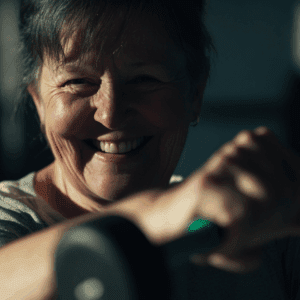Every year, 1 in 4 adults aged 65 and older experiences a fall - many of them serious, and many of them preventable.
But here’s the critical truth:
Falls rarely come out of nowhere.
In most cases, the body has been sending quiet warning signals for weeks or even months. We just don’t always know how to spot them.
If you’re supporting an aging parent or loved one, understanding the early, hidden signs of walking instability could prevent a devastating fall - and protect their independence, confidence, and health.
Here’s how to detect the subtle signs of declining balance before it's too late.
Why Falls Are So Dangerous - and So Preventable
Falls are the leading cause of injury-related hospitalizations in older adults. A bad fall can result in:
- Hip fractures
- Head injuries
- Long-term loss of mobility
- Increased risk of cognitive decline
- A loss of confidence or fear of leaving the house
But many of these injuries are preventable with early detection and small interventions - especially if you catch the subtle signs of instability before a fall happens.
👉 Here's some helpful Facts about Falls from the CDC on
Subtle Signs Your Loved One May Be Losing Balance
Walking "just fine" doesn’t always mean walking safely.
Here are less obvious signs that could point to growing instability:
1. Using Furniture for Support
Do they steady themselves using walls, countertops, or furniture while walking around the house?
This often indicates balance insecurity - even if they don’t admit it.
2. Avoiding Certain Activities or Rooms
Are they suddenly reluctant to go upstairs, step outside alone, or walk down the hallway at night?
They may be quietly compensating for a fear of tripping or falling.
3. Shorter, Shuffled Steps
A noticeable change in stride length or a slight “shuffle” can be an early sign of reduced confidence, joint stiffness, or poor proprioception (body awareness).
4. Unexplained Bruises or “Bumps”
If you see bruises on hands, arms, or legs - but no clear explanation - it could be from small stumbles or catches they’re not mentioning.
5. Slower Transitions
Watch how they:
- Stand up from a chair
- Turn while walking
- Step over thresholds
If these movements seem cautious, slow, or stiff, they may be masking underlying unsteadiness.
6. Unusual Fatigue During Movement
Do they sit more often or seem winded after walking even short distances?
Fatigue can signal reduced strength and endurance - two key factors in fall risk.
7. Reduced Engagement in Physical Activity
If they used to take daily walks or go to the shops but now prefer staying put, it may not be laziness—it could be fear of falling.
What Causes These Balance Changes?
Walking steadiness declines for many reasons, including:
- Age-related muscle loss
- Joint pain or stiffness
- Vision or hearing changes
- Medication side effects
- Neurological conditions like Parkinson’s or dementia
- Inner ear problems affecting balance
- Cognitive overload or confusion
Some changes are temporary or treatable - others require long-term support. But all deserve early attention.
What You Can Do to Help - Before a Fall Happens
Here’s how to take action without creating resistance or fear:
🟢 1. Observe Without Judgment
Start by quietly watching your loved one move around the home.
Notice patterns, hesitations, or changes - but avoid jumping in to correct or overprotect immediately.
🟢 2. Start a Conversation
Instead of saying “You’re going to fall,” try:
- “I’ve noticed you seem a little off balance lately. Have you felt unsteady?”
- “How does your walking feel to you these days?”
- “Would it be helpful to look at a few ideas together to stay safe and independent?”
🟢 3. Encourage Gentle Movement
Improving walking steadiness is possible - at any age.
Encourage:
- Simple strength exercises (e.g., chair stands)
- Balance work (heel-to-toe walking)
- Light daily walking routines
- Supportive stretching or yoga
👉 Related reading: Simple Home Exercises That Boost Brain Health
🟢 4. Make the Environment Safer
Fall-proof the home by:
- Removing throw rugs and clutter
- Adding grab bars near toilets and showers
- Using non-slip mats in wet areas
- Improving lighting - especially at night
- Keeping everyday items within easy reach
🟢 5. Use Technology to Support, Not Monitor
Apps like Elli Cares let families:
- Set up Safe Zones to receive alerts if a loved one moves outside familiar areas
- Track activity patterns to spot changes
- Send scheduled reminders to move, drink water, or take medications
- Use video check-ins to stay connected
These tools can support walking safety - without constant oversight or control.
👉 Related blog: Walking Steadiness: Why It Matters and How to Improve It
When to Talk to a Doctor
If you notice any of the warning signs mentioned above, it’s a good idea to bring them up with a GP, physiotherapist, or geriatric specialist.
They can:
- Assess gait and balance
- Review medications
- Recommend physical therapy
- Rule out underlying medical issues
- Suggest mobility aids or exercises
Early medical input = better outcomes.
Falls don’t usually happen “out of the blue.”
The body gives clues - if we know how to read them.
By learning to spot the early signs of instability, families can take small, respectful steps to support their loved one’s confidence, safety, and independence.
At Elli Cares, we believe mobility is freedom - and it’s worth protecting early.
Let’s help seniors move with confidence, not fear.








